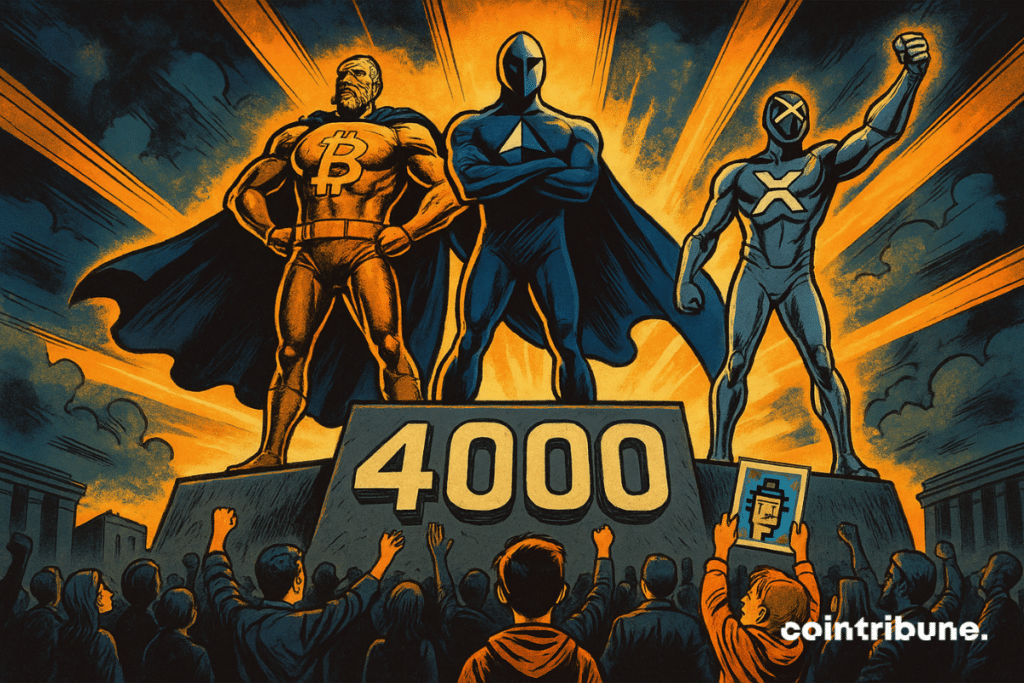Crypto Hits $4 Trillion Milestone: The Ecosystem Grows Up (And Gets Interesting)
Crypto’s not just surviving—it’s thriving. The $4 trillion market cap milestone isn’t just a number; it’s proof the wild west of finance is building railroads.
From Chaos to (Some) Order
Remember when ‘crypto’ meant shady exchanges and Dogecoin memes? Now institutional money’s elbowing in—with all the paperwork and lawsuits you’d expect from traditional finance.
The New Power Players
DeFi protocols now handle more volume than some small nations’ GDPs. NFTs? Beyond bored apes—they’re ticketing concerts and verifying diplomas. Even the SEC’s lawsuits can’t slow this down.
The Cynic’s Corner
Sure, $4 trillion sounds impressive—until you remember banks lose that much in overdraft fees every long weekend. But crypto’s here to stay… whether Wall Street likes it or not.

In brief
- The crypto market once again crosses the 4,000 billion dollar capitalization threshold, an unprecedented level since 2021.
- Bitcoin confirms its dominant position with more than 62 % of the market capitalization, absorbing the majority of incoming flows.
- The CoinGecko report highlights a structural market shift, marked by a decrease in volumes on CEXs (-27.7 %) and a rise in power of DEXs (+25.3 %).
- The crypto market enters a phase of maturity, characterized by increased decentralization, a focus on major assets, and a new relationship with stock markets.
The rise of leaders : Bitcoin, Ethereum, and XRP at the forefront
Driven by a massive inflow of capital, the crypto market experienced a significant rebound in the second quarter of this year. The CoinGecko report highlights a clear concentration around Bitcoin, which absorbs the majority of flows, propelling the crypto market capitalization to 3.8 T$ just a few days ago.
Capital has massively moved towards Bitcoin, pushing its market dominance beyond 62 %, while altcoins struggle to regain momentum. ethereum also stands out by maintaining and strengthening its position among key assets, with a market share of 10.8 %.
BTCUSDT chart by TradingViewTogether, these two assets now represent more than 70 % of the total capitalization, signaling a return to values perceived as “safe havens” in an still volatile context.
However, it is undoubtedly XRP that causes the most remarkable surprise this quarter. The crypto shows spectacular growth, becoming the third largest market capitalization, driven by exceptional dynamics in Asian markets. In South Korea, trading activity on Upbit, one of the country’s main exchanges, has surged. The CoinGecko report provides precise figures :
- XRP price : surpasses $3.60 ;
- Market capitalization : over 210 billion dollars ;
- XRP/KRW trading volume on Upbit : 2.2 billion dollars in 24 hours ;
- Share of total Upbit volume represented by XRP : 33 %.
This rise is notably explained by the strong appetite of the Korean public for XRP, an asset historically appreciated for its volatility, low unit price, and direct liquidity via KRW pairs.
The report highlights that this phenomenon is typical of the Korean market: “XRP has always sparked keen interest among investors because of its low unit price, high volatility, and popularity with local traders.”
This situation probably triggered a wave of momentum buying, amplified by easier access to fiat currency.
Towards a structural shift : DEXs gain ground
Beyond the price surge, the CoinGecko report informs us of a deeper trend: a gradual shift of trading volumes to decentralized platforms. While spot volumes on CEXs dropped by 27.7 % to 3,900 billion dollars in the second quarter, DEXs recorded a growth of 25.3 %, reaching 876.3 billion dollars.
“The data indicates much more than a simple recovery,” emphasizes CoinGecko. They reflect an increasing transition towards decentralization, both at the level of infrastructures and trading behaviors. In other words, the mutation goes beyond prices: it is the very market architecture that is evolving.
The performances of platforms like PancakeSwap, which captures 45 % of DEX volume, and Hyperliquid, which concentrates 72.7 % of decentralized derivatives volume, illustrate this rise in power. The perpetuals platform alone generated 653.2 billion dollars in volume in the second quarter.
This dynamism fits into a context where disintermediation becomes a strategic axis, driven by the search for transparency, sovereignty, and reduced exposure to regulatory risks affecting CEXs.
This reshaping of the landscape has been reinforced by related events such as Circle’s (CRCL) IPO. Oversubscribed 25 times, the stock peaked at $298.99 shortly after its launch at $31. Although volatile, this IPO acted as a catalyst of interest for “points of convergence between crypto and stock markets,” showing a renewed institutional interest in hybrid models between traditional finance and crypto.
Crossing the 4,000 billion dollar threshold is not just a return to euphoria for markets. It also reveals a transformation in investment behaviors, a rise in decentralization, and the beginning of convergence between traditional finance and the crypto ecosystem. This structural evolution, more than a simple cyclical improvement, demands a multi-level reading. While Bitcoin, Ethereum, and XRP still dominate volumes, it’s the DEXs, hybrid models, and new forms of market access that shape the future. At a time when regulation intensifies especially in the United States and institutional attention awakens, the crypto market seems to enter a phase of maturity… without giving up its disruptive capacity.
Maximize your Cointribune experience with our "Read to Earn" program! For every article you read, earn points and access exclusive rewards. Sign up now and start earning benefits.

